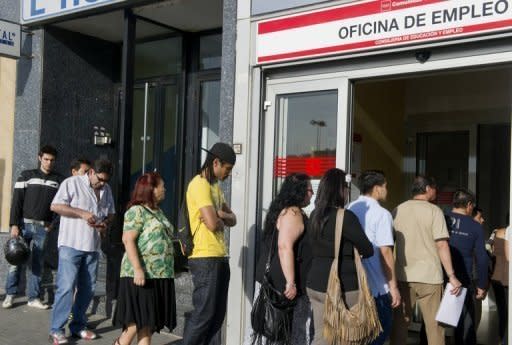Eurozone jobless rate hits record 11.1%
The eurozone debt crisis delivered more bad news on Monday with data showing record high unemployment of 11.1 percent and a manufacturing outlook at its lowest levels for three years. Unemployment hit its highest point since the eurozone was created in 1999 and analysts warned that job queues would likely continue to lengthen in coming months. "It now looks odds-on that the eurozone unemployment rate will reach 11.5 percent by the end of the year, although the situation will vary markedly between countries," forecast Howard Archer, chief economist at IHS Global Insight. More than 17.5 million people were jobless in the 17-nation eurozone in May, as 88,000 more men and women lined up for benefits. Spain was the hardest hit with almost one in four unemployed, according to Eurostat data agency. Youth unemployment surged again, with 3.4 million people under 25 looking for work, an increase of 254,000 from 12 months earlier. "It was of little real comfort that May's rise in unemployment was actually the smallest for 11 months," Archer noted. A key survey meanwhile showed that manufacturing activity remained at its lowest level since the summer of 2009, with the second quarter registering the biggest contraction for three years. "We fear that the 'growth pact' agreed by EU leaders last week will not be enough to foster a sustained recovery -- and that more is likely to be needed, starting with an ECB rate cut on Thursday," said Martin van Vliet of ING. European Union leaders agreed at the summit on growth measures to offset budget reforms imposed on debt and deficit sinners that some say have choked struggling economies. Van Vliet said the pace of reform should be slowed if politically feasible. Capital Economics economist Mark Miller noted that "the labour market is a lagging indicator of overall economic conditions. So it is of particular concern that recent business surveys have pointed to renewed recession across the euro-zone," he said. Both the employment data and bleak manufacturing PMI figures raised the risk of eurozone unemployment reaching 12 percent, van Vliet commented. The eurozone unemployment rate has stayed above 10 percent for 13 months as the bloc struggles to revive economies undermined by a debt crisis now in its third year and threatening major economies in Spain and Italy. In the wider 27-nation European Union, unemployment rose to 10.3 percent against 10.2 in April, the same level as in March. About 24.86 million men and women were jobless in the EU as unemployment increased by 151,000 people. Spain posted once again the worst unemployment rate at 24.6 percent, with more than one in two people under 25 without work. Greece was next at 21.9 percent in March, the latest available figures for that country, followed by Latvia at 15.3 percent in the first quarter and Portugal at 15.2 percent in May. Austria has the lowest rate at 4.1 percent, followed by the Netherlands at 5.1 percent, Luxembourg at 5.4 percent and Germany at 5.6 percent. The Purchasing Managers Index (PMI), a survey of 3,000 manufacturers compiled by the London-based research firm Markit, remained unchanged in June from May at 45.1 points, from 45.9 in April. Any level below 50 points indicates economic contraction. The rate of decline for the second quarter from the first was the biggest since the same period in 2009. "Companies are clearly preparing for worse to come, cutting back both on staff numbers and stocks of raw materials at the fastest rates for two-and-a-half years," said Markit economist Chris Williamson. Ireland, however, proved an exception in gloom, registering a 14-month high figure of 53.1 in the pace of manufacturing expansion. Powerhouse Germany saw its steepest decline in three years to 45.0 points however, its fourth successive monthly fall. "With the eurozone likely having suffered appreciable GDP (gross domestic product) contraction in the second quarter and in grave danger of contracting again in the third, and with eurozone business confidence generally low and fragile, the likelihood is that the eurozone unemployment rate will move significantly higher over the coming months," Archer concluded.




